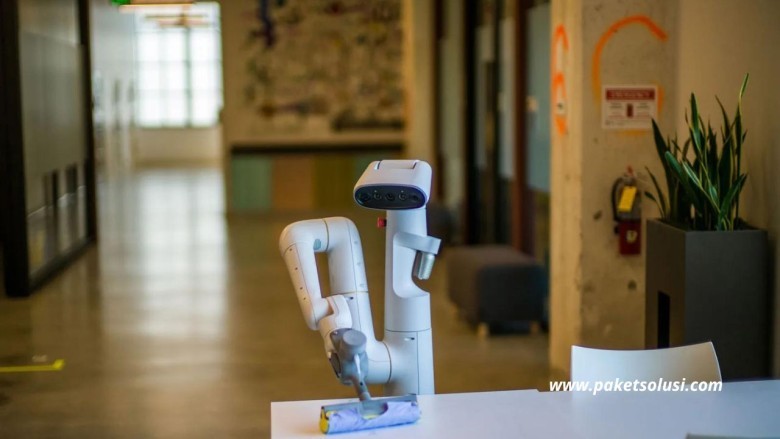views
Google AI Robot: The Quest to Give AI a Physical Body
In a world where artificial intelligence (AI) is increasingly becoming a part of our daily lives, the next big leap is giving AI a physical body. Google, through its innovative lab, has been at the forefront of this journey. Their mission? To bring AI-powered robots into the real world, working alongside us to handle everyday tasks.
This exploration into Google AI robots isn't just about creating machines that look like us. It's about building robots that can learn, adapt, and function in the complex, unpredictable environments we live in. Let's dive into Google's approach to robotics and AI and the challenges faced in this ambitious endeavor.
The Birth of Google AI Robotics
The story of Google AI robots started in 2016, when the company set out to integrate artificial intelligence into physical machines. The goal was simple but profound: to address significant global issues such as labor shortages, aging populations, and the need for automated assistance. However, developing robots that could seamlessly interact with the world around us was no small feat.
Unlike traditional robots confined to factory floors, Google's vision was to create robots capable of working in everyday settings – homes, offices, hospitals, and more. To achieve this, they needed a combination of breakthrough technology, innovative thinking, and a willingness to take big risks.
What Makes a Moonshot?
Within Google’s X lab, moonshots are projects that aim to solve some of the world’s biggest challenges using advanced technology. For a project to be considered a "moonshot," it must meet three criteria:
- Address a Global Problem: The project should aim to impact hundreds of millions or even billions of people.
- Breakthrough Technology: The project must leverage a new, innovative technology that changes how we solve a particular problem.
- Radical Solution: The solution should push the boundaries of what's possible, almost seeming "crazy" at first glance.
Google's AI robotics project, known as Everyday Robots, ticked all these boxes. The objective was to build autonomous robots that could assist with a wide range of daily tasks. This was more than just another tech experiment; it was a bold attempt to reshape the role of robotics in society.
The AI Body Problem
The challenge wasn't just creating a robot; it was giving AI a "body" that could navigate the messy, unpredictable real world. Most existing robots were large, clunky, and limited to controlled environments like warehouses and factories. In contrast, Google wanted to build robots that were safe, helpful, and capable of functioning in diverse everyday settings.
The key to achieving this goal lay in artificial intelligence. Unlike traditional programming, where robots are coded to perform specific tasks in specific conditions, AI allows robots to learn and adapt through experience. However, this approach brought new challenges, as teaching robots to perform even simple tasks in an unpredictable environment is exceptionally hard.
Why AI-Powered Robots Are So Difficult to Build
Building robots that can work alongside humans isn't just a hardware problem – it's a systems problem. A robot is only as good as its weakest link. For example, if its vision system struggles with direct sunlight, it could become "blind" in certain conditions, making it unreliable. Similarly, if it can't recognize stairs, it might fall and cause harm.
To make AI robots truly functional, Google needed to build robots that could learn and adapt to various conditions, much like humans do. This involved training the AI to perceive objects, navigate different environments, and perform tasks without pre-defined instructions. The real world is unpredictable, and the robots needed to handle this unpredictability gracefully.
Two Approaches to AI in Robotics
Google explored two primary approaches for integrating AI into robotics:
-
Hybrid Approach: This involves using AI to power specific parts of the robot, such as vision, while traditional programming manages the overall system. For example, the AI might identify objects in its surroundings, and then a traditional program decides how to interact with those objects.
-
End-to-End Learning (E2E): In this approach, the robot learns entire tasks through exposure to large amounts of training data. Much like how a child learns by observing and practicing, the robot learns tasks like "picking up an object" or "tidying up a table" through trial and error. Over time, it improves by continuously learning from its successes and failures.
The second approach, E2E learning, was seen as the ultimate goal. If robots could successfully learn entire tasks autonomously, they could potentially handle the unpredictability of real-world environments.
Robots That Learn Through Experience

To train the robots, Google used machine learning. Imagine a group of robotic arms, placed in a lab, trying to pick up different objects like Lego blocks, sponges, or plastic toys. At the start, their success rate was minimal – just around 7%. However, each time they succeeded, they received positive reinforcement, gradually improving their performance.
This learning process went on for months, and over time, the robots became more adept at picking up objects. The real breakthrough came when the robots began to exhibit behaviors they hadn't been explicitly programmed for. For instance, they learned to push obstacles out of the way to reach an object, showcasing their growing adaptability.
But learning to pick up a single object wasn't enough. Real-world applications required much more complex actions. To accelerate learning, Google created a cloud-based simulator, enabling hundreds of thousands of virtual robots to practice tasks simultaneously. This "robot dream world" allowed them to gather vast amounts of data quickly, speeding up the training process.
The Power of Data in AI Robotics
One critical realization from this project was that building functional AI robots is a massive data problem. Teaching robots to navigate, interact, and assist in the real world requires an enormous amount of data. While simulations can provide some of this data, they can't replace the nuances of real-world experience.
For this reason, Google believes that it will take many thousands, perhaps millions, of robots interacting in the real world to gather enough data to train effective end-to-end models. This is why the development of AI robots is not a quick process – it requires continuous learning, adaptation, and refinement.
Read also: What is Kubernetes? Understanding Its Role and Functions in Cloud Computing
The Debate: Should Robots Look Like Us?
When building robots, one of the biggest debates is whether they should resemble humans. Some argue that human-like robots would fit seamlessly into environments designed for humans. However, others, including Google's robotics team, believe that mimicking humans isn't always the best path.
Robot legs, for example, are mechanically complex, power-inefficient, and slow. Wheels, on the other hand, are more practical for many tasks. The focus at Google was on building robots that could perform useful tasks, regardless of whether they looked like us. This approach allowed them to prioritize functionality and collect valuable data faster.
From the Lab to the Real World
The ultimate goal was to bring AI robots out of the lab and into everyday settings. One of the team's milestones was creating a robot that could "tidy up" a workspace. This involved recognizing objects like cups, wrappers, and other items, picking them up, and placing them in the appropriate place. The fact that the robot could do this without explicit programming for each step was a significant achievement.
This success demonstrated that the hybrid approach – combining traditional programming with AI learning – could produce practical results. By focusing on real-world tasks, Google's robots continued to improve, inching closer to the goal of becoming helpful, autonomous assistants.
Google's Vision for the Future of AI Robots
The journey to create functional AI robots is ongoing. While significant progress has been made, there is still a long way to go. Robots that can autonomously live and work alongside humans will require a combination of AI, traditional programming, and vast amounts of real-world data. This means it will be years, if not decades, before AI robots become a common sight in homes, offices, and public spaces.
However, the potential impact is enormous. From assisting the elderly to automating mundane tasks, AI robots could reshape our lives in ways we are just beginning to imagine. Google's mission to give AI a robot body is not just about technological achievement; it's about addressing real-world challenges and enhancing human life.
Conclusion: A New Era in Robotics
Google's journey to create AI robots represents a bold step into the future of robotics. By focusing on building robots that learn, adapt, and function in our everyday environments, they are pushing the boundaries of what's possible. This mission is not without its challenges, but the potential rewards – transforming how we live and work – are well worth the effort.
As AI and robotics continue to evolve, one thing is clear: the robots are coming. But rather than looking like us, they will be designed to complement our lives, assist with the tasks we need help with, and learn to navigate the complexities of our world. And while it may take time, Google's ambitious moonshot is paving the way for a future where AI robots become an integral part of society.
Embrace the future. The era of AI robots is just beginning.





















Comments
0 comment